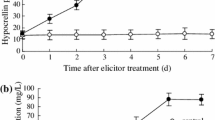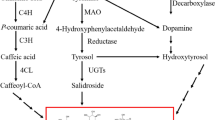Abstract
This work was to characterize the generation of nitric oxide (NO) in Taxus yunnanensis cells induced by a fungal-derived cerebroside and the signal role of NO in the elicitation of plant defense responses and taxol production. (2S,2′R,3R,3′E,4E,8E)-1-O-β-d-glucopyranosyl-2-N-(2′-hydroxy-3′-octadecenoyl)-3-hydroxy-9-methyl-4,8-sphingadienine at 10 μg/ml induced a rapid and dose-dependent NO production in the Taxus cell culture, reaching a maximum within 5 h of the treatment. The NO donor sodium nitroprusside (SNP) potentiated cerebroside-induced H2O2 production and cell death. Inhibition of nitric oxide synthase activity by phenylene-1,3-bis(ethane-2-isothiourea) dihydrobromide or scavenging NO by 2-(4-carboxyphenyl)-4,4,5,5-tetramethylimidazoline-1-oxyl-3-oxide partially blocked the cerebroside-induced H2O2 production and cell death. Moreover, NO enhanced cerebroside-induced activation of phenylalanine ammonium-lyase and accumulation of taxol in cell cultures. These results are suggestive of a role for NO as a new signal component for activating the cerebroside-induced defense responses and secondary metabolism activities of plant cells.







Similar content being viewed by others
References
Cusidó RM, Palazón J, Navia-Osorio A, Mallol A, Bonfill M, Morales C, Piñol MT (1999) Production of Taxol® and baccatin III by a selected Taxus baccata callus line and its derived cell suspension culture. Plant Sci 146:101–107
de Pinto MC, Tommasi F, Gara LD (2002) Changes in the antioxidant systems as part of the signaling pathway responsible for the programmed cell death activated by nitric oxide and reactive oxygen species in tobacco Bright-Yellow 2 cells. Plant Physiol 130:698–708
Delledonne M, Xia Y, Dixon RA, Lamb C (1998) Nitric oxide functions as a signal in plant disease resistance. Nature 394:585–588
Delledonne M, Zeier J, Marocco A, Lamb C (2001) Signal interactions between nitric oxide and reactive oxygen intermediate in the plant hypersensitive disease resistance response. Proc Natl Acad Sci USA 98:13454–13459
Garcês H, Durzan D, Pedroso MC (2001) Mechanical stress elicits nitric oxide formation and DNA fragmentation in Arabidopsis thaliana. Ann Bot 87:567–574
Glazener JA, Orlandi EW, Harmon GL, Baker JC (1991) An improved method for monitoring active oxygen in bacteria treated suspension cells using luminol-dependent chemiluminescence. Physiol Mol Plant Pathol 39:123–133
Hu X, Neill SJ, Cai W, Tang Z (2003) Nitric oxide mediates elicitor-induced saponin synthesis in cell cultures of Panax ginseng. Funct Plant Biol 30:901–907
Koga J, Yamauchi T, Shimura M, Ogawa N, Oshima K, Umemura K, Kikuchi M, Ogasawara N (1998) Cerebrosides A and C, sphingolipid elicitors of hypersensitive cell death and phytoalexin accumulation in rice plants. J Biol Chem 273:31985–31991
Lamotte O, Gould K, Lecourieux D, Sequeira-Legrand A, Lebrun-Garcia A, Durner J, Pugin A, Wendehenne D (2004) Analysis of nitric oxide signaling functions in tobacco cells challenged by the elicitor cryptogein. Plant Physiol 135:516–529
Levine A, Tenhaken R, Dixon R, Lamb C (1994) H2O2 from the oxidative burst orchestrates the plant hypersensitive disease resistance response. Cell 79:583–593
Li JC, Ge ZQ, Yuan YJ (2005) Ce4+-stimulated ion fluxes are responsible for apoptosis and taxol biosynthesis in suspension cultures of Taxus cells. Biotechnol Bioprocess Eng 10:109–114
Neill SJ, Desikan R, Hancock JT (2003) Nitric oxide signaling in plants. New Phytol 159:11–22
Ochoa-Alejo N, Gòmez-Peralta JE (1993) Activity of enzymes involved in capsaicin biosynthesis in callus tissue and fruits of chili pepper (Capsicum annuum L.). J Plant Physiol 141:147–152
Pedroso MC, Magalhaes JR, Durzan D (2000) Nitric oxide induces cell death in Taxus cells. Plant Sci 157:173–180
Shu RG, Wang FW, Yang YM, Liu YX, Tan RX (2004) Antibacterial and xanthine oxidase inhibitory cerebrosides from Fusarium sp. IFB-121, an endophytic fungus in Quercus variabilis. Lipids 39:667–673
Suharsono U, Fujisawa Y, Kawasaki T, Iwasaki Y, Satoh H, Shimamoto K (2002) The heterotrimeric G protein α subunit acts upstream of the small GTPase Rac in disease resistance of rice. Proc Natl Acad Sci USA 99:13307–13312
Tan RX, Chen JH (2003) The cerebrosides. Nat Prod Rep 20:509–534
Umemura K, Ogawa N, Koga J, Iwata M, Usami H (2002) Elicitor activity of cerebroside, a sphingolipid elicitor, in cell suspension cultures of rice. Plant Cell Physiol 43:778–784
Umemura K, Ogawa N, Yamauchi T, Iwata M, Shimura M, Koga J (2000) Cerebroside elicitors found in diverse phytopathogens activate defense responses in rice plants. Plant Cell Physiol 41:676–683
Umemura K, Tanino S, Nagatsuka T, Koga J, Iwata M, Nagashima K, Amemiya Y (2004) Cerebroside elicitor confers resistance to Fusarium disease in various plant species. Phytopathology 94:813–818
Wu J, Lin L (2003) Enhancement of taxol production and release in Taxus chinensis cell cultures by ultrasound, methyl jasmonate and in situ solvent extraction. Appl Microbiol Biotechnol 62:151–155
Wu J, Wang C, Mei X (2001) Stimulation of taxol production and excretion in Taxus spp cell cultures by rare earth chemical lanthanum. J Biotechnol 85:67–73
Xu MJ, Dong JF (2005) Elicitor-induced nitric oxide burst is essential for triggering catharanthine synthesis in Catharanthus roseus suspension cells. Appl Microbiol Biotechnol 67:40–44
Yamasaki H, Sakihama Y (2000) Simultaneous production of nitric oxide and peroxynitrite by plant nitrate reductase: in vitro evidence for the NR-dependent formation of active nitrogen species. FEBS Lett 468:89–92
Yuan YJ, Li C, Hu ZD, Wu JC, Zeng AP (2002) Fungal elicitor-induced cell apoptosis in suspension cultures of Taxus chinensis var. mairei for taxol production. Process Biochem 38:193–198
Acknowledgments
This work was supported by grants for R.X.T. from NSFC (30470191) and for J.W.W. from NSF for universities in Jiangsu Province (05KJB360120), MSDF of Soochow University (EE132514).
Author information
Authors and Affiliations
Corresponding author
Additional information
Taxol is a trademark of Bristol-Myers Squibb, Madison, NJ.
Rights and permissions
About this article
Cite this article
Wang, J.W., Zheng, L.P. & Tan, R.X. Involvement of nitric oxide in cerebroside-induced defense responses and taxol production in Taxus yunnanensis suspension cells. Appl Microbiol Biotechnol 75, 1183–1190 (2007). https://doi.org/10.1007/s00253-007-0927-7
Received:
Revised:
Accepted:
Published:
Issue Date:
DOI: https://doi.org/10.1007/s00253-007-0927-7




